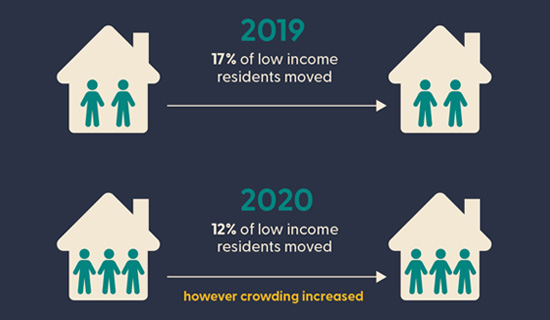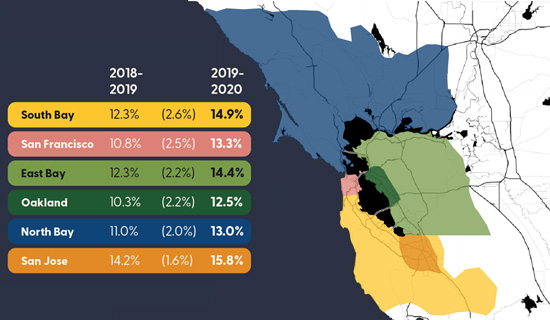The economic fallout from the COVID-19 pandemic has been extensive and far-reaching, especially for communities already experiencing residential and financial instability.
In a new report, my co-authors and I examined residential instability—which includes moving, crowding, and financial health—in the San Francisco Bay Area during the pandemic. Our analyses draw from a unique, longitudinal dataset that covers more than 250,000 Bay Area residents to examine various aspects of residential inability in the area during the first year of the pandemic, compared with before the pandemic.
Here are our top takeaways from the research.
The Bay Area’s poorest residents moved less frequently during the pandemic, but more people began living in crowded housing.
During the first year of the pandemic, we saw fewer people moving out of their block group.1 This trend was particularly notable for residents of extremely low socioeconomic status (SES).

At the same time, more households started living in crowded conditions. This trend may indicate that during the first year of the pandemic, people moved into shared living spaces with friends or family who live in the same census block group; it could also reflect young adults living elsewhere who may have moved back home to the Bay Area during this time.
People living in places hit hardest by COVID-19 experienced more residential and financial instability.
When we looked at the relationship between COVID case rates and residential instability, we found strong correlations between areas with high COVID case rates and increases in residents living in crowded housing, new financial delinquencies, and declines in financial health as measured by credit scores.
Trends in residential stability are unequal across Bay Area neighborhoods.
Neighborhoods with at least a 10% Black population, or mixed-Black neighborhoods, experienced the largest decrease in moving rates during the pandemic and the largest increase in people living in crowded conditions.2
The data also showed residents of certain neighborhoods in the Bay Area may be more vulnerable to residential instability. Moves into crowded conditions, new delinquencies, and declines in financial health were concentrated in the southeast parts of San Francisco, the eastern and northern parts of the North Bay, southeast Oakland, the northeast of the East Bay, central San Jose, and central South Bay.

Alternative strategies may be necessary to reduce residential instability for low-SES residents.
The decrease in moving rates for extremely low-SES residents suggests that policies enacted during the pandemic, such as eviction moratoria and rent relief programs, may have been successful in helping people stay in their homes. However, the increase in residents living in crowded housing and declines in financial health show that this group may benefit from additional strategies and support that address other forms of residential and financial instability.
When examining residential instability, it’s critical to pay attention to racial and income disparities.
Our analyses found that residents across all neighborhoods moved less and shifted to crowded housing more during the pandemic. However, these rates were more pronounced for residents in mixed-Black neighborhoods and residents in the extremely low-SES group, showing that certain neighborhoods and cities are more vulnerable to residential instability than others.
When considering strategies to reduce this instability, examining the conditions and complexities across racial and income categories may help to inform responses to reduce displacement, crowding, and financial instability.
Jason Vargo is a senior researcher in community development focused on understanding the role of climate risks and equity in ensuring an inclusive and prosperous economy for all. He brings a wealth of experience at the intersection of climate and health equity as well as healthy and resilient urban planning.
You may also be interested in:
- How Do Homeowner Experiences Vary by Race and Ethnicity? Neighborhood Differences between Hispanic and White Homebuyers
- Will Rising Rents Push Up Future Inflation?
- Overlooked Suburbs: The Changing Metropolitan Geography of Poverty in the Western United States
1. We define a block group as a cluster of census-designated blocks that contains approximately 600-3,000 residents.
2. Ethnoracial categories used in this study are inherited from previous national analyses. See Crowder, Kyle, Jeremy Pais, and Scott J. South. “Neighborhood diversity, metropolitan constraints, and household migration.” American sociological review 77, no. 3 (2012): 325-353.
The views expressed here do not necessarily reflect the views of the management of the Federal Reserve Bank of San Francisco or of the Board of Governors of the Federal Reserve System.

